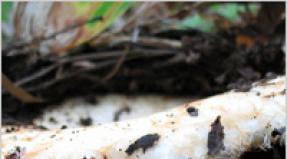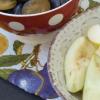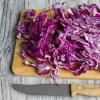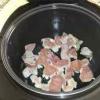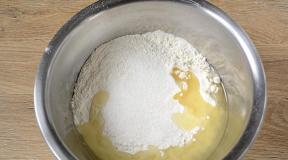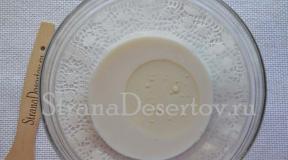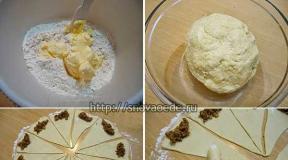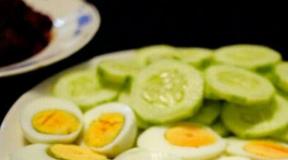Rice vodka name. How to make rice "Sake" at home? Is sake wine or vodka? Sake premium and super premium
Secondly, sake is not always drunk hot. The serving temperature depends, first of all, on the variety of sake: the best Japanese rice wines - premium, super premium, author's - lose all the richness of taste and aroma when heated, so it is better to drink them chilled.
There is also a third. "Sake" is not the official name for this drink. In Japan, sake is called the word nihonshu(Nihon - Japan, shu - sake) or seishu. The latter name is enshrined in Japanese law.
What do you need to make sake?
For production use only polishedrice, since only the center of the rice grain contains the starch needed for fermentation. When grinding, from 25% to 70% of the upper layers of grain are removed. After grinding, the rice is washed, soaked and steamed.
In addition to rice, water, koji and shubo are also used to make sake. Koji- these are grains of rice affected by the mold fungus kojikin, aka aspergillus oryzae. Word syubo called yeast starter, which in turn is made from rice, water, koji and yeast.
Both koji and shubo participate in a unique technology double parallel fermentation. The fact is that rice has starch, and there is no natural sugar. Therefore, classical fermentation (the conversion of sugar into alcohol under the influence of yeast) is impossible. This is where it comes to the rescue koji- Rice grain affected by mold fungus. Koji has a special enzyme that extracts sugar from starch, which is then processed by yeast into alcohol. Both fermentations (rice starch + koji = sugar, sugar + sourdough shubo = alcohol) occur at the same time.
After the double fermentation, the unrefined sake goes through pressing, filtration, two pasteurizations and aging. And only after that it is bottled.
table sake
Main sake classification built on the degree of polishing of rice. All varieties of sake can be divided into two categories: futsu-shu" (ordinary, table sake) and " tokutei-meisho-shu» (all types of premium sake).
« Futsu-shu» (ordinary, table sake) is made from rice, which, as a rule, loses about 10% of its original mass during grinding. There are no requirements for polishing rice for table sake, sake is made according to a simplified scheme - from the simplest varieties of rice, with the addition of "fermented" strong alcohol, sugar (glucose, etc.).
The classic serving of table sake can charm a person in love with the traditional culture of the Land of the Rising Sun. The drink is poured from a small ceramic jug (tokkuri) into small cups (choko), designed for only two or three sips. The serving temperature depends on the weather and time of year. Table sake can be kept at room temperature (this method of serving is called "hiya") or heated to 35-40% ( "kan-zake"). It is heated in a specially designed ceramic vessel in a water bath. The main thing is not to boil, in this case the sake completely loses its aroma.
Sake premium and super premium
« Tokutei-meisho-shu” (named sake) combines eight varieties of high-quality sake, the production of which is regulated by Japanese law.
To base premium(residue of rice during polishing is 70%) are " honjojo-shu"(with the addition of "fermented" strong alcohol no more than 10% of the weight of the fermented grounds) and " junmai-shu"(without the addition of "fermented" strong alcohol).
To the class premium(residue of rice during polishing is 60%) are " tokubetsu honjozo-shu” (prepared in the same way as “honjozo-shu”, but with more thorough polishing of rice), “ ginjo-shu"(sake of slow fermentation at low temperatures, the addition of "fermented" strong alcohol - no more than 10%), " tokubetsu junmai-shu" (prepared in the same way as "junmai-shu", but with more thorough polishing of rice), " junmai ginjo-shu” (prepared in the same way as “ginjo-shu”, but without the addition of “fermented” strong alcohol).
To the class super premium(residue of rice during polishing is 50%) are " daiginjo-shu" (i.e. "great ginjo-shu", prepared in the same way as "ginjo-shu", but with more thorough polishing of rice) and " junmai daiginjo-shu"(Different from "daiginjo-shu" by the absence of "fermentation" strong alcohol additives).
Non-table species sake(i.e. related to "t okutei-meisho-shu”), except, perhaps, sake of the “basic premium” category, in Japan it is customary to serve in glass (not ceramic) choko cups. In Europe, the tradition of serving premium sake in wine glasses has become stronger. In addition, non-table sake never warm up so as not to lose its unique taste and aroma. Serving temperature - 20-25% (room temperature, method "hiya", for any variety) or 10-18% (chilled, method "suzubie» , for premium and super premium varieties).
More about varieties of sake
Sake is also classified according to other criteria. Sake produced by small companies and having a strong personality is called " copyright”, “boutique” (“ jizake"). It happens to be filtered (purified, " sei-shu"") and unfiltered (unrefined, " nigorizake»); pasteurized and unpasteurized (live, " namazake"). It still happens nama-chozo-shu" (aged "live", not subjected to pasteurization before aging) and " nama-zume-zake(bottled "alive"). " Xing-shu" is a "young" sake that goes on sale within a year from the date of its manufacture, " siboritate" is a "young" sake that goes on sale immediately after pressing, " ko-shu"- "old" sake, aged for more than a year, " taruzake” (“barrel”) - aged in wooden barrels. Sake can also be " gen-shu"(natural strength, undiluted - 18-20% vol.)," tei-arukoru-shu"(lowered fortress - 8-10% vol.)," namachozo" (unpasteurized sake with lees), " yamahai» (produced in an ancient way using natural yeast, without the addition of a special yeast starter).
Sake and cuisine
Sake is universal: it goes well not only with sashimi, sushi, maki-zushi (the real name of “rolls”), but also with chips, cheese, nuts.
At the same time, one must understand that table sake and not very fragrant sake of a higher class (for example, “honjozo-shu”) are always just a neat accompaniment to the kitchen.
At the same time, types of sake that are brighter in aroma (for example, “daiginjo-shu”, most of the “author's” sake) enter into a kind of dialogue with the dish, sometimes subjugating the taste of the dish, so the advice of a sommelier may be needed here.
By the way
Based sake made in Japan shochu- local "vodka". It is driven not only from rice, but also from other cereals, as well as from sweet potato, however, an important component of any kind of shochu will always be koji - grains of rice affected by mold. Shochu Korui- this is a "first-class" shochu, which is obtained as a result of repeated distillation (strength - no higher than 36%, most often 25%). Shochu Otsuruy- shochu "second grade", which is produced by a single distillation (fortress - no higher than 45%).
Rice vodka (sake) has become widespread due to its unique, incomparable taste. The product is the national drink in Japan. It does not belong to any category of alcoholic beverages. It can be consumed both hot and chilled. The Japanese often add sake to various dishes to emphasize their sophistication and originality. What are the secrets of making the original rice vodka? How to get it at home?
The history and features of the preparation of the national Japanese drink
Sake first appeared in Japan about 2,000 years ago. Initially, the process of preparing this drink was simple and primitive. It consisted in chewing and fermenting rice. After the discovery of moldy fungus koji, the technology changed. This substance became a substitute for saliva during fermentation. Today, in Japan, rice vodka is produced on a large scale. In almost every locality of the country there is a plant where the production of this drink is carried out. There are hundreds of recipes for its preparation.
The production process begins with a special preparation of rice. For this, a special coarse-grained cereal is grown. It is carefully polished, washed, and stored for some time in a room with high humidity. The last preparatory step is steaming. Next, the moldy koji fungus is introduced into the grain mass. Its peculiarity lies in the ability to convert starch into alcohol. The resulting mixture is combined with yeast. Fermentation is carried out for three months. After their expiration, the drink is filtered and bottled.
Sake is classified into several types. Based on the level of strength, spiciness and sweetness, there are both light and scalding drinks. Young vodka has a light yellow color, while aged vodka is dark. The taste of alcohol of this type has fruity notes. The reason for this fact is unknown even to experienced specialists.
How to cook at home
It takes about three weeks to produce sake at home. To get a drink with an original taste, you must carefully follow the technology. You will need the following ingredients:
- high-quality polished rice - 180 g;
- purified water - 300 ml;
- special moldy rice fungus - 100 g;
- freshly squeezed lemon juice - 3 ml;
- yeast - 3 g.
The cooking process is step by step. The following technology must be observed:
- Rice preparation. The grains are moved and filled with water for 12 hours to obtain a more pronounced taste. After washing, the cereal is boiled. For this, a steamer is used. Traditional cooking in a saucepan over low heat is allowed.
- Fermentation. The cooled mixture is placed in a pre-sterilized container. Lemon juice, fungus and yeast are introduced here. The mass is thoroughly mixed. It should take up a third of the volume of dishes. The latter is placed in a darkened cool place. The mash is mixed daily. The container is closed with an ordinary rubber glove or a water seal.
- Filtration and storage. During fermentation, small bubbles appear. After about three weeks, the gases stop being released. Sediment forms at the bottom. This indicates that the drink is ready and can be filtered. For filtering, cotton wool is used, placed between several layers of gauze. Sake is poured into a glass, hermetically sealed bottle. Rice vodka is stored in a cold place.
Based on this recipe, you can get 500 ml of drink. The fortress will be about 20 degrees. To make more sake, the amount of ingredients must be increased proportionately. For long-term storage of rice vodka, pasteurize the drink after filtering for 10 minutes at a temperature of 60 degrees.
Revealing the flavor of modern alcoholic products, you are guaranteed not to be able to pass by sake, popularly referred to as rice vodka.
This is a special segment of alcohol, which, with its gastronomic and aromatic characteristics, is able to win the hearts of the consumer already in the first minutes of tasting.
Moreover, these drinks fit perfectly into any atmosphere. They can be purchased for organizing large parties, as well as for spiritual pastime in the company of best friends.

Sake is one of the brightest examples of the exemplary craftsmanship of Japanese specialists. This is a traditional alcoholic drink that has been a kind of hallmark of the country for several millennia.
It hides magnificent taste and aroma outlines, capable of enveloping unsurpassed pleasant emotions from the first moments of tasting. There are two types of Japanese rice vodka on the market today, namely:
- Futsushu. The most popular table variety. 75% of the market is represented in this style.
- Tokutei meishoshu. Premium alcohol. It accounts for 25% of the market.
How many degrees in sake
Previously, the classic varieties of sake had a strength of 18-20 degrees, but today on the market you can increasingly find products diluted with water with a degree measure of 10-15%.
Color
The visual flavor of rice vodka is based on yellow-amber and greenish products. It all depends on the ingredients and how they are processed.
Aroma
Aromatic indicators emerge with fresh trails of grapes, mushrooms, cheese, bananas, soy sauce.
Taste
Gastronomic indicators embody a symbiosis of bitter sherry nuances with pleasant fruity aspects.
Did you know? Often the product we are considering is called “rice wine”, but this statement is considered erroneous, since its manufacturing technology involves mold fermentation with the formation of rice malt mash.
Production technology
As practice shows, each sake manufacturer today creates alcohol according to its original recipe. At the same time, the manufacturing principles have remained unchanged for several hundred years.
- Initially, manufacturers grind rice.
- Next, it is washed, soaked and then steamed.
- As soon as the base reaches the required indicators, the specialists begin to prepare the koji dough. This stage lasts from 35 to 48 hours.
- This is followed by the preparation of the primary “moto” mash, when rice, yeast and water are added to the resulting dough. In this state, the product is left for 2-4 weeks.
- The next stage is the creation of the main moromi congestion. Rice and water are again added to the product, leaving everything to ferment for at least 4 days.
- One of the last stages of production is pressing and filtering. They are carried out on the most modern equipment using carbon filters and automatic presses.
- The finished product is sent for 6-12 months to special sealed vats, where it is pasteurized.
How to purchase an original product

If you are interested in Chinese rice vodka or the Japanese varieties of spirits we are considering, beware. The procedure for acquiring alcohol these days is closely associated with great risks.
The consumer systematically has to deal with a large number of fakes that can distort the taste and aroma impressions of the taster.
In particular, if you do not want to make a mistake with the choice of drink for today's tasting, we recommend that you pay attention to:
- Place of purchase.
A branded Japanese product today can only be presented in specialized stores or large supermarket chains. You should not buy rice vodka in stalls and grocery stores where you cannot be provided with appropriate quality certificates for products.
- Excise stamp.
All foreign alcohol that goes through customs clearance is required to have an excise tax. This element of protection may be absent only on bottles offered for sale in duty free.
- Appearance.
The structure of branded rice vodka should not contain sediment, turbidity and other impurities. These are perfectly clean and transparent drinks that undergo long-term aging and filtration.
- Decor.
Each manufacturer of Japanese alcohol offers the consumer to taste his product from the original bottle. Therefore, before buying alcohol, we recommend that you visit the official website of a particular company to get acquainted with the original external design of branded packaging.
We also note that Japanese companies are responsible for the quality of design, excluding any factory defects both on the bottles themselves and on labels or caps.
Did you know? Choya is the most popular sake in the world.
How to serve

The signature moonshine made from rice is best served according to classic tasting principles. Such drinks are bottled both in ordinary glasses and in traditional Japanese ochoko or sakazuki.
An important point in the tasting process is given to the serving temperature. It is best to drink rice vodka chilled to 5 degrees. In this form, it shows the perfect aromatic and gastronomic balance.
What products are combined with
Today, every consumer can either buy rice vodka in a store or discover the secret of what it is. Whatever method you choose, you should pay special attention to the gastronomic accompaniment.
You should not serve drinks with excessively fatty or spicy dishes, as they can distort the taste of alcohol. Otherwise, there are no particular restrictions. Experienced tasters recommend enjoying sake with Japanese cuisine.
Did you know? Sake was first exported to other countries in the 17th century.
Other uses
As practice shows, it works great in combination with a large number of ingredients. In other words, you can create a solid variety of alcoholic mixes on sake, which can be the perfect addition to a bright party.
Examples of cocktails that will leave you with the most interesting and vivid impressions are Saketini, Tamagozake, Bloody Mariko, Screwdriver and Sake Bomba.
What are the types of this drink

Considering the possibility of purchasing branded rice vodka, today you will get acquainted with an impressive list of offers from famous Japanese companies.
The most interesting representatives of the segment in the international arena include such products as:
- Choya. Alcohol of transparent color with soft dry aftertaste and delicate aroma.
- Kitcho Hozan. Light golden spirit with a round and powerful aftertaste. Aromatic indicators symbolize an elegant fruity balance.
- Hakushika Honjozo Namachozo. Light-colored rice vodka with attractive floral undertones on the palate. The bouquet is formed from various trains of cheese and yeast.
- Homare Aladdin Yuzu. It has the most delicate lemon color and demonstrates a recognizable citrus share in the aroma. The gastronomic foundation is built on light tangerine, lime and lemon plumes, decorated with spicy bitterness.
History reference
According to numerous finds by archaeologists and research by historians, the Japanese began to brew rice vodka more than 2,000 years ago. Moreover, for a long time this alcoholic product was created exclusively at the imperial courts, and only in the Middle Ages they began to brew it in ordinary village communities.
Did you know? In Japan, sake is also called nihonshu.
Original accompaniment to your evening

Real Japanese vodka will be an ideal solution for the consumer who wants to create not just a relaxing, but the most pleasant atmosphere during the tasting.
These drinks show an excellent light nature, which allows them to be combined with a large number of snacks. Moreover, on the basis of a high-quality product, you can easily create an impressive variety of cocktails that will surely delight you with bright and unforgettable emotions at the time of tasting.
Visit your nearest specialty alcohol store today to find the perfect accompaniment for your upcoming tasting.
Rice vodka at home is prepared for about 3 weeks. Therefore, we advise you to be patient if you want to know the traditional taste of this drink.
Leave the rice to soak overnight - this is done to achieve the best taste of the finished drink.
As soon as the rice absorbs all the water, you can start making vodka. It is best to steam the rice, but you can do it in any familiar way - in a saucepan or a cauldron. Try to cook the rice for as long as possible, this will strengthen the walls of the grains and lead to a longer fermentation.

It is known that the longer the fermentation process lasts, the “sake” tastes better. Using the rice vodka recipe, you can make a great drink. If you like exotic dishes like sushi, sake will not only decorate the festive table, but will also be a nice addition to a Japanese-style party.
Once the rice has cooled, transfer it to a bottle or jar where the sake wort will ferment. Try to do this as evenly as possible. Be sure to sterilize the dishes before starting cooking - the quality of the drink depends on the cleanliness of the bottle or jar.Add all the remaining ingredients, close the lid and shake well to mix everything completely. Keep jars of rice vodka "sake" in a cool, dark place and shake daily, slightly opening the lid. It is best to use a water seal or a regular rubber glove for this purpose.

After a few days, you will notice that the wort has fermented - small bubbles will rise to the top of the jar. This process will end by the third week and then sediment will be noticeable at the bottom of the jar, and bubbles will stop appearing.

Now you need to strain the drink with gauze, pour it into bottles and refrigerate. Using this recipe for rice vodka, you will get one bottle of a good Japanese drink.

Therefore, if you want to make more sake next time, increase the amount of ingredients, respecting the proportions.
In the countries of Japan, China and Vietnam, rice vodka enjoys great respect, being considered a divine nectar and a drink for true gourmets. Therefore, earlier it was produced exclusively at the distilleries of the imperial palaces and wealthy feudal lords.
1 The mystery of Japanese vodka production technology
The preparation of Japanese rice vodka, or, as it is also called, sake, differs significantly from the process and technology for the production of wheat vodka familiar to everyone. Understanding in more detail, you can see that its receipt is in many ways reminiscent of fermentation. It is due to the fact that this drink is not subjected to distillation, it turns out special.
To get a truly high-quality drink, manufacturers use exclusively polished rice, the kernels of which contain a high amount of starch necessary for successful fermentation.
According to the original production recipe and depending on the type of alcohol, from 25 to 75% of the upper layers of the grain are removed. At the end, the rice is steamed, soaked and filtered.
Important components of Japanese rice vodka are koji rice grains affected by the mold fungus kojik, and yeast sourdough - shubo. It is these ingredients that play a major role in the double parallel fermentation. Of course, koji grains play a special role. They help release sugar from rice starch. And the addition of yeast sourdough completes the fermentation. This is followed by pressing, careful filtration, pasteurization, aging and bottling.
2 What is Vietnam preparing for us?
In Vietnam, Vietnamese rice vodka with the names "Nep Moi" and "Le Moi" is especially popular. It has varying degrees of quality - from homemade moonshine to the premium Kai drink. If we talk about the highest quality vodka, we use rare yellow rice, which grows exclusively in the Hong Ha River valley. And to give the drink a special flavor, the local tropical lychee fruit is used, which has a unique sweet taste, as well as an intoxicating aroma with notes of orange blossom and rose.

Vietnamese rice vodka appears in the recipes of many tinctures among the locals. And it's not just herbal medicines. Walking around the outskirts of Vietnam, you will definitely see showcases with tinctures from wood lizards, seahorses, snakes and goat entrails. The Vietnamese drink such drinks in piles, and tourists treat this exotic with caution.
Many varieties of Vietnamese vodka are also made from red rice varieties, but this alcohol is not for everyone. If you are lucky enough to ever visit Vietnam, then do not miss the opportunity to taste Zieu Kae vodka, which uses white glutinous rice. After all, the main thing here is not even taste, but the ceremony of drinking. Therefore, take a large company with you on a trip to enjoy this alcohol directly from a jug (can) using thin reed tubes.
3 Maotai - loves the government and the whole country
This Chinese rice vodka is made from shanlan early sticky rice, which is grown specifically for the production of the beloved alcohol. The harvested rice is ground into a powder and yeast is added to it. A distinctive feature of the preparation of rice vodka in China is the high temperature of fermentation, as well as eight distillation. All this takes about a month, and then distillation occurs. Further, according to the recipe, the Chinese drink is sent to the cellar, where it is aged for 3 years. But that's not all. At the end of the allotted time, "young" vodka is combined with more seasoned. These manipulations are carried out in order to eliminate the difference in taste of different batches of this alcohol. As a result, properly prepared Maotai has a strength of about 53 ° C.

Attention to detail and fidelity to the original recipe for making this alcohol made it very popular among high society, so it can also be called a classic drink for diplomats. So Chinese vodka is often presented to the highest ranks of other countries as a sign of the deepest reverence and respect. Therefore, it is not surprising that Maotai is one of the three most famous alcoholic beverages. At one time, such great statesmen as Deng Xiaoping, Zhou Enlai and Mao Zedong enjoyed this national pride of China.
4 Intoxicating sake at home
To prepare a bottle of Japanese rice vodka, you will need to soak one cup of polished rice overnight. In the morning, the rice will swell well and absorb all the moisture. Now it must be filled with water and sent to cook on a slow fire. It is best to steam rice for as long as possible so that the walls of the grains become denser. We transfer the finished cooled rice to the bottle in an even layer, having previously sterilized the jar. Additionally, half a cup of rice fungus (koji) and half a teaspoon of yeast must be added to the rice container. Lightly cover the glass jar with a lid and shake it well.

Do not close the container tightly so that gas exchange begins. After a few days, you will notice the appearance of the first bubbles, which will signal you about the start of fermentation. But by the end of the third week, this process will be completely over, and sediment will appear at the bottom of the jar. Now it remains only to strain the finished sake through a thick layer of gauze and squeeze the rice mass well.
Sake prepared according to this recipe has a short shelf life of about a month. Therefore, for better preservation of the product, it is recommended to sterilize rice vodka for 10 minutes at a temperature of 60 °C. After that, the finished alcohol will have a cloudy hue, but if you put it in the refrigerator for several days, it will become transparent. Sake prepared at home should have a strength of 15-20 degrees. If such a degree turns out to be too high for you, then the recipe allows adding a teaspoon of sugar to a bottle of vodka.
And some secrets...
Russian scientists from the Department of Biotechnology have created a drug that can help in the treatment of alcoholism in just 1 month.
The main difference of the drug is ITS 100% NATURALITY, which means efficiency and safety for life:
- eliminates psychological cravings
- eliminates breakdowns and depression
- protects liver cells from damage
- Gets out of heavy drinking in 24 HOURS
- COMPLETE RELEASE from alcoholism, regardless of the stage
- very affordable price.. only 990 rubles
Course reception in just 30 DAYS provides a comprehensive SOLUTION TO THE PROBLEM WITH ALCOHOL.
The unique ALKOBARRIER complex is by far the most effective in the fight against alcohol addiction.
Follow the link and find out all the benefits of an alcohol barrier
